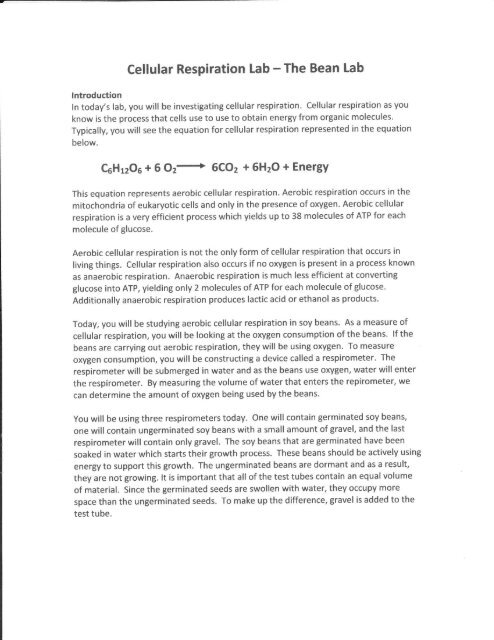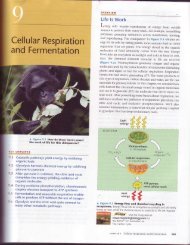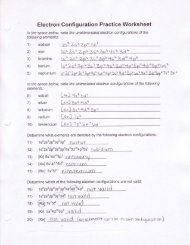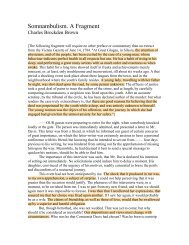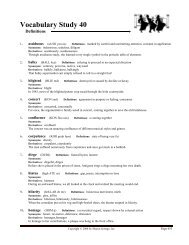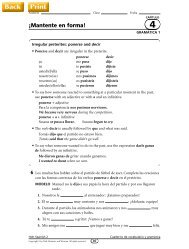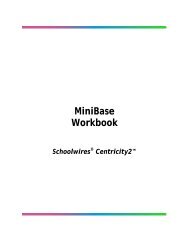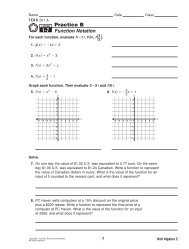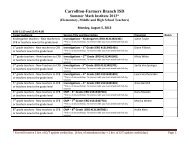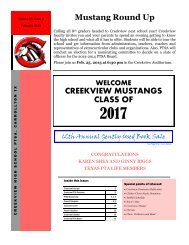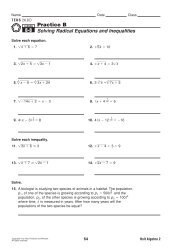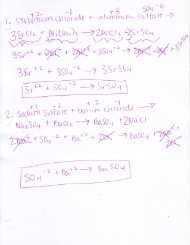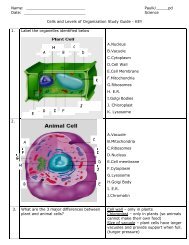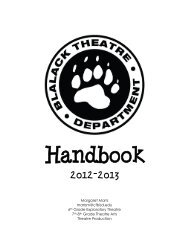Cell Respiration Bean Lab
Cell Respiration Bean Lab
Cell Respiration Bean Lab
Create successful ePaper yourself
Turn your PDF publications into a flip-book with our unique Google optimized e-Paper software.
<strong>Cell</strong>ular <strong>Respiration</strong> <strong>Lab</strong> - The <strong>Bean</strong> <strong>Lab</strong><br />
lntroduction<br />
In today's lab, you will be investigating cellular respiration. <strong>Cell</strong>ular respiration as you<br />
know is the process that cells use to use to obtain energy from organic molecules.<br />
Typically, you will see the equation for cellular respiration represented in the equation<br />
below.<br />
CeHrzOo + 6 Oz+ 5CO2 + SHzO + EnergY<br />
This equation represents aerobic cellular respiration. Aerobic respiration occurs in the<br />
mitochondria of eukaryotic cells and only in the presence of oxygen. Aerobic cellular<br />
respiration is a very efficient process which yields up to 38 molecules of ATP for each<br />
molecule of giucose.<br />
Aerobic cellular respiration is not the only form of cellular respiration that occurs in<br />
living things. <strong>Cell</strong>ular respiration also occurs if no oxygen is present in a process known<br />
as anaerobic respiration. Anaerobic respiration is much less efficient at converting<br />
glucose into ATP, yielding only 2 molecules of ATP for each molecule of glucose.<br />
Additionally anaerobic respiration produces lactic acid or ethanol as products.<br />
Today, you will be studying aerobic cellular respiration in soy beans. As a measure of<br />
cellular respiration, you will be looking at the oxygen consumption ofthe beans. lf the<br />
beans are carrying out aerobic respiration, they will be using oxygen. To measure<br />
oxygen consumption, you will be constructing a device called a respirometer. The<br />
respirometer will be submerged in water and as the beans use oxygen, water will enter<br />
the respirometer. By measuring the volume of water that enters the repirometer, we<br />
can determine the amount of oxygen being used by the beans.<br />
You will be using three respirometers today. One will contain germinated soy beans,<br />
one will contain ungerminated soy beans with a small amount of gravel, and the last<br />
respirometer will contain only gravel. The soy beans that are germinated have been<br />
soaked in water which starts their growth process. These beans should be actively using<br />
energy to support this growth. The ungerminated beans are dormant and as a result,<br />
they are not growing. tt is important that all of the test tubes contain an equal volume<br />
of material. Since the germinated seeds are swollen with water, they occupy more<br />
space than the un8erminated seeds. To make up the difference, gravel is added to the<br />
test tube.
Name per _ Date<br />
<strong>Cell</strong>ular <strong>Respiration</strong> <strong>Lab</strong> Pre-lab<br />
Read the introduction and the lab procedures before answering the questions below.<br />
1. What is cellular respiration?<br />
2. What are two types of cellular respiration?<br />
b.<br />
3. What are the differences between both types of cellular respiration?<br />
4. What is the equation for cellular respiration?<br />
5. What type of cellular respiration does the equation above represent?<br />
6. How much ATP does the process above release?<br />
7. What organism will be used in today's lab?<br />
8. What isthe difference between a germinated seed and an ungerminated seed?<br />
9. How will you measure the amount of cellular respiration that occurs in the lab today?<br />
10. You will set up three respirometers today. Below describe what will be in each.<br />
o.<br />
11. lf orygen is consumed in the experiment, how will you know?
12. Describe how you will set up a respirometer.<br />
13. Oxygen is taken up in this experiment, and carbon dioxide gas is given off in equal<br />
amounts. In order to be able to observe how much oxygen is being used by the seeds,<br />
the carbon dioxide must removed from the resoirometer. Describe how this will be<br />
accomolished.<br />
14. What is the purpose of the gravel in the test tube with the ungerminated soy beans?<br />
15. How do you correct for atmospheric pressure or the effect of temperature changes<br />
during the experiment?<br />
16. Which of the three test tubes do vou think will have the most cellular respiration?<br />
Explain why you think so.<br />
17. Write out a predictive hypothesis for this experiment in correct form.
Nome<br />
Dote<br />
AEROBTC CELLULAR RESPTRATTON (BEAN LAB)<br />
fn this experiment, you will compore the oxygen consumption of<br />
nongerminoting soybeons ond genminoting soybeons.<br />
Oxygengos is consumed during oerobic cellulor respirotion ond corbon<br />
dioxide gas is given oIf. The uptoke of oxygen is the evidence thot on<br />
orgonism is corrying on oerobic cellulor respirotion. Your doto will not be<br />
affected by the releose of corbon dioxide becquse you will use potossium<br />
hydroxide (KOH) to remove it. Note the following eguotions fon:<br />
the removol of COz6Y KOH is' 6Q, + ?KOH ---------2 KzCOt + HzO<br />
oerobic cellulor respirotion ist C5HpO5+ Oz (Q2 + ll2O + ATP<br />
EXPERIMENTAL PROCEDURE<br />
-_2<br />
1 - Prepore o room temperoture woter both:<br />
Fiff o green tub to q level of -5 centimeters of woter.<br />
Attoch mosking tGPe ocross the woter both, moking q "sling" to hold the<br />
respirometer pipette ends out of the water (see Figure b)'<br />
2 - Construct three respirom elers (see Figure o):<br />
Obtain three test tubes, eoch with o stoPPer ond calibroted pipette'<br />
Lobel the tubes 1, 2, ond 3 with the greose pencil in your desk drawer'<br />
3 - Follow all the remoining directions CAREFULLy!<br />
place oneof the six smoll wods of obsorbenf cotton in the bottom of each<br />
test tube.<br />
Carefully dispense drops of 15%KOH (potossium hydnoxide) to saturote the<br />
cotton in the tubes (fully wet, but not so99y). Do not get ony KOH on the<br />
sides of the test tubes; the tube 4gg! be dry. Reploce o tube with o<br />
clean one if you occidentolly get the sides wet.<br />
ploce o smoll wod of dry cotton on top of eoch of the KoH-sooked cotton<br />
wads. Use the some qmounts of cotton ond KoH for eoch respirometer.<br />
4 - Obtoin o 100 ml groduoted cylinder ond odd 50 ml of woter'<br />
Drop in twenty germinoted soybeons ond meosure the omount of woter<br />
disploced (thot is, how much the woter rises qbove the 50 ml mork)'<br />
Record this number here: ml.<br />
Remove the woter ond germinoting beons.<br />
Gently dry the beons on o Poper towel.<br />
5 - Plqce the germinoting beons in tube 1.<br />
fnsert the stoPper fitted with o colibroted pipette (seeFigure a)'
tube 1<br />
germinatrng<br />
bears,<br />
no gravel<br />
Figure a<br />
tube 2<br />
nongermlna ting<br />
bears & gravel<br />
tube 3<br />
aqua.riu.Er<br />
gravel<br />
d.I-t cotton<br />
KOH soaked<br />
cotton<br />
Figure b<br />
. Respiromeiers in the !'/ater bath'<br />
Beon lab P.2<br />
masking<br />
lape sllng<br />
6 - Again, add 50 ml of woter to the 100 ml groduoted cylinder. This time,<br />
drop in tweniy nongerminoting soybeons.<br />
Add oguorium grovel until the some omount of woter is disploced os in step 4.<br />
Dry the gravel ond beans on o paper towel.<br />
7 - Place the nongerminoting beons and the grovel in tube Z.<br />
fnsert the stopper fitted with o colibrated pipette.<br />
8 - Once more, odd 50 ml of water to the 100 ml cylinder.<br />
Then, drop in grovel uniil the some omount of water is disploced os in step 4.<br />
Remove the woter qnd gravel.<br />
Dry the grovel on o poper towel.<br />
9 - Placethe grovel in tube 3.<br />
fnsert the stopper fitted with o colibroted pipetle.<br />
10 - Using the test tube tongs, loy tha three respirometers in the woter<br />
bqth, with the pipettes resiing on the mosking tope sling (seeFigureb).<br />
Qently set the weight opparotus ocross the three tubes to submerge them.<br />
Woit 7 minutes so the temperature of the tubes ond the woten is the some.<br />
11 - Remove the sling.<br />
Using the test tube tongs, position the three respirometers ond the weight<br />
dpporotus dtagonallyin the tub so thot they loy entirely under water ond so<br />
the pipette colibrotions con be eosily read (keep those warm fingers out of<br />
the woterl).<br />
Water will enter the pipettes fon o short distonce ond then stop.<br />
ff woten continues to move into o pipette, check for leoks in the<br />
respiiomefer (with fingernoil, try gently pushing down the waxy parafiln<br />
thot seols the pipette to the stopper hole. If this doesn't correct the<br />
problem, exchange your pipette stopper for onother from the cort.)<br />
pipetl<br />
tip
Nome Beon lob p. 3<br />
t? - Allow the respinometers to eguilibrote for 3 minutes.<br />
To the nearest 0.01 ml, record in the toble the initiol position of woter in<br />
eoch pipette.<br />
Woit 10 minutes ond record in the toble ony chonge in woter position.<br />
Woit 10 more minutes, ond ogain record ony chonge in woter position.<br />
13 - Record in the toble the net change fon eoch test tube - thot is, the<br />
initial reoding for eoch tube minusthat fube's ZO-minute reoding.<br />
Did the water position chonge in tube 3 (grovel only)?<br />
By how much? _ ml.<br />
Add this number to the net chonge you obsenved in tubes l ond 2 if the<br />
woter position moved toword the tip of the pipette.<br />
Subtract this number from the net chonge you observed in tubes 1 ond 2 if<br />
the woter position moved toword the tube. This is o correction for ony<br />
chonge in volume due to otmospheric pressure chonges or temperoture<br />
chonges.<br />
Complete the foble.<br />
Aerobic <strong>Cell</strong>ular Resp rotion toble<br />
Test<br />
tube Contenis<br />
1<br />
3<br />
Initio I<br />
reodrn9<br />
Reoding @<br />
10 rninuies<br />
Reading @<br />
20 minutes<br />
t4 - At the end of the experiment:<br />
Place the used gravel ond beons in the dishes provided on the side counter.<br />
Use the hooked probe to remove the cotton bolls-<br />
Wosh the test tubes ond set them in the dish droiner.<br />
Return oll other eguipment to the cort.<br />
Net<br />
cnonge Correction<br />
CoffecIed<br />
net change
<strong>Cell</strong>ular <strong>Respiration</strong> <strong>Lab</strong> Write Up<br />
Include the following in a Word document: Be sure to label each distinct section of the write up<br />
1. Title<br />
2. Background Information - Write a paragraph that answers and summarizes the following:<br />
a. What is the purpose of cellular respiration?<br />
b. Explain the entire process of converting glucose to ATP through aerobic respifation. Include a discussion of<br />
each step in the process, where it occurs and what it produces.<br />
c. Explain how the rate of cellular respiration was measured in the lab. Relate this measure to process of cellular<br />
respiration and explain why that is an effective way to measure the rate of cellular respiration.<br />
d. Explain why KOH was required in the lab. Relate this need for KOH to the process of cellular respiration.<br />
3. Hypothesis - Write the specific prediction that you tested as an if...then statement.<br />
4. Experiment<br />
a. Summarize the procedures that you followed in this experiment<br />
b. ldentify the independent variable<br />
c. ldentify the dependent variable<br />
d. Explain how the dependent variable was measured<br />
5. Data - Make a data table. Include both class and group data if appropriate<br />
6. Results<br />
a. Graph your data - remember the independent variable is placed on the X axis, the dependent variable is on<br />
the Y axis<br />
b. <strong>Lab</strong>el what is graphed on each axis<br />
7. Conclusion<br />
a. Restate your hypothesis<br />
b.Using data from the exp€riment, explain whether you accept or reject your hypothesis<br />
c. ldentifi/ any possible sources of error that might have impacted your data_<br />
d. Discuss what you learned about cellular respiration
Name per._ Date<br />
<strong>Cell</strong>ular <strong>Respiration</strong> <strong>Lab</strong> Write Up Grading Rubric<br />
l4s<br />
Write your name on this sheet and turn it in with your type written lab report<br />
1. Typed: 0 not typed 2 typed<br />
2. Title: 0 not oresent 2 oresent<br />
3. Sections <strong>Lab</strong>eled: 0 no sections labeled I some sections labeled 2 all sections labeled<br />
4. Backgroundlnformation<br />
Paragraph form: 0 not in paragraph form 1 partially in paragraph form Z paragraph form<br />
a. <strong>Cell</strong>ular respiration purpose:0 not present 1 present incomplete/incorrect 2 present, correct<br />
b. Process of <strong>Cell</strong>ular <strong>Respiration</strong>:<br />
Glycolysis: 0 not present 1 present incomplete/incorrect 2 present, correct<br />
Krebs Cycle: 0 not present 1 present incomplete/incorrect 2 present, correct<br />
Electron Transport System: 0 not present 1 present incomplete/incorrect 2 present, correct<br />
c. Measurement of Oxygen: 0 not present 1 present incomplete/incorrect 2 present, correct<br />
d. Role of KOH: 0 not present 1 present incomplete/incorrect 2 present<br />
5. Hypothesis: 0 not present 1 present,illogical 2 present, logical, wrong format 3 present, correct<br />
6. Experiment<br />
a. Procedure summary: 0 not present 1 present incomplete/incorrect 2 present, correct<br />
b. Independent variable: 0 not present l present incorrect 2 present, correct<br />
c. Dependent variable: 0 not present l present incorrect 2 present, correct<br />
d. Dependent variable measured: 0 not present 1 present incomplete/incorrect 2 present, correct<br />
7. Data: 0 not present 1 present incomplete/incorrect 2 present, correct<br />
8. Results<br />
a. Graph: 0 not present 1 present incomplete 2 present, variables on wrong axes 3 present, correct<br />
b. Axes <strong>Lab</strong>eled: 0 not present 1 present incomplete/incorrect 2 present, correct<br />
9. Conclusions<br />
a. Hypothesis restated: 0 not present 1 present incomplete/incorrect 2 present, correct<br />
b. Conclusion: 0 not present 1 present illogical 2 present, no data 3 present correct<br />
c. Sources of Error: 0 not present 1 present incomplete/incorrect 2 present, correct<br />
d. Discussion of <strong>Cell</strong>ular <strong>Respiration</strong>: 0 not present 1 present incomplete/incorrect 2 present, correct


